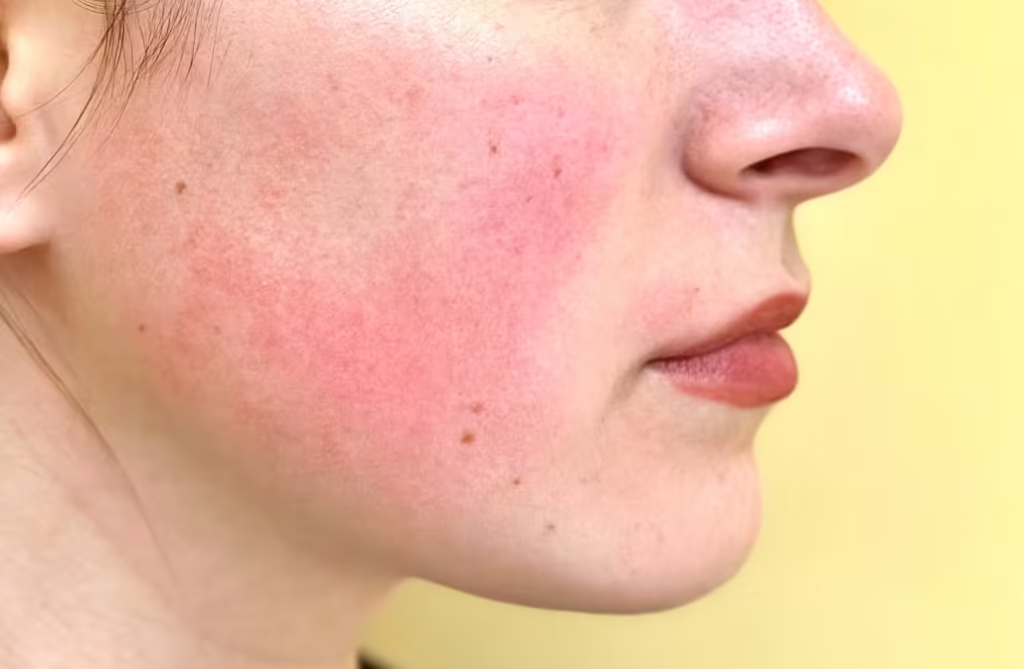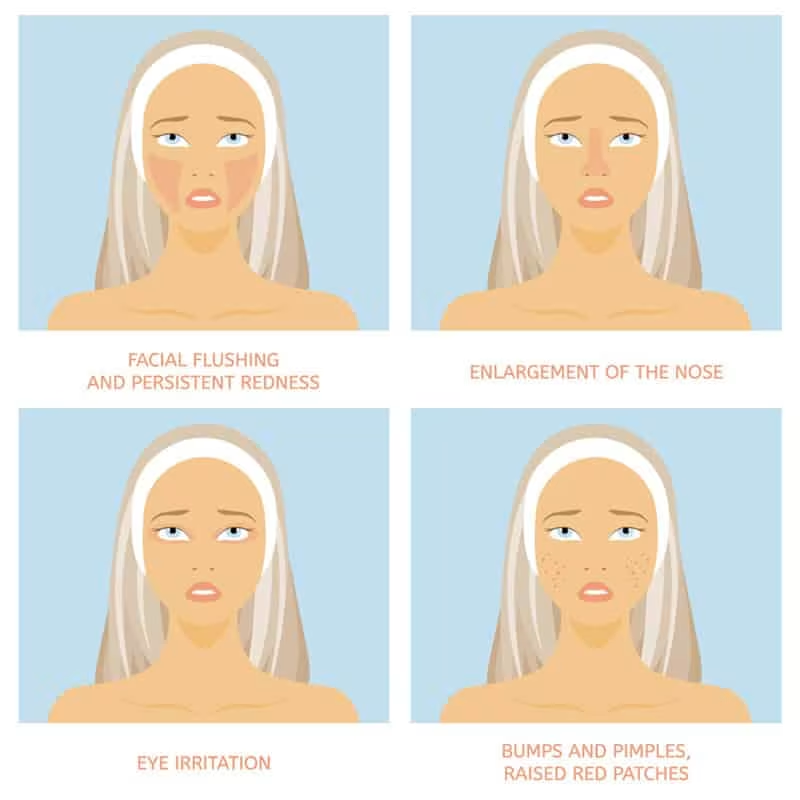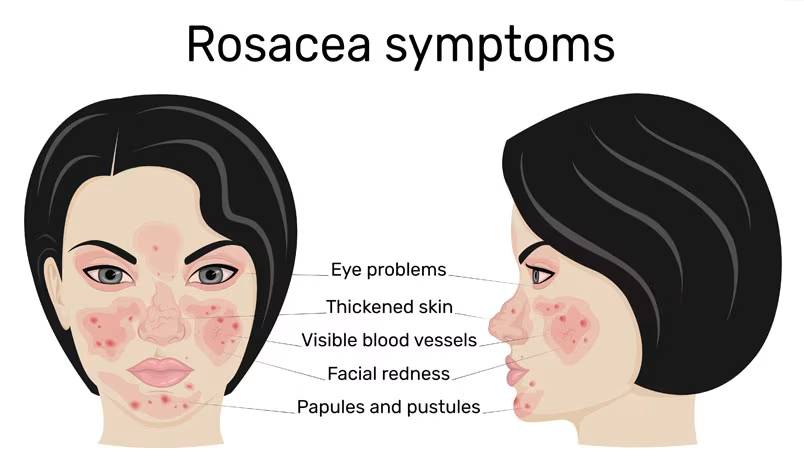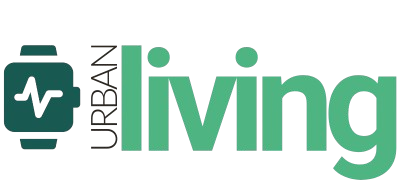Rosacea is a common yet often misunderstood chronic skin condition that affects millions worldwide, including many Singaporeans.
Despite popular misconception, rosacea isn’t exclusive to those with fair skin—it affects individuals across all skin tones and ethnicities.
If you’re struggling with persistent facial redness, visible blood vessels, or acne-like breakouts, you might be among the 2-10% of the global population living with rosacea.
Understanding Rosacea: What Is It?

Rosacea is a chronic inflammatory skin disorder that primarily affects the facial skin. Typically beginning after age 30, it manifests as redness on the cheeks, nose, chin, or forehead that may come and go initially.
Over time, this redness becomes more persistent, often accompanied by skin swelling, visible tiny blood vessels (telangiectasia), and small bumps resembling acne.
In some patients, the eyes may also be affected, becoming watery or bloodshot—a condition known as ocular rosacea.
Long-standing and severe cases can lead to rhinophyma, where the nose grows swollen and lumpy from excessive tissue buildup.
You might be interested: Guide to Seeing a Dermatologist in Singapore
The Four Types of Rosacea

Rosacea presents differently from person to person, and many individuals experience characteristics of multiple types simultaneously.
Understanding which type(s) you have is crucial for effective treatment:
- Erythematotelangiectatic Rosacea (ETR): Characterized by persistent facial redness, flushing, and visible blood vessels. This is the most common type, often accompanied by skin sensitivity, stinging, burning, and dryness.
- Papulopustular Rosacea: Also known as “acne rosacea,” this type presents with acne-like breakouts alongside facial redness. Patients typically develop red, swollen bumps and pus-filled pimples, commonly appearing on the cheeks, chin, and forehead.
- Phymatous Rosacea: This rare subtype leads to thickening and enlargement of the skin, primarily affecting the nose (rhinophyma). The skin may develop a bumpy, irregular texture with enlarged pores. In severe cases, the nose can appear bulbous.
- Ocular Rosacea: Affecting the eyes, this type causes symptoms like redness, irritation, dryness, and sensitivity to light. Patients may experience a gritty, burning sensation and visible blood vessels on the eyelids.
You might like: Which Dermatologist in Singapore Should You Consider? (Sort by Reviews)
Signs and Symptoms to Watch For

Rosacea manifests through a range of visible symptoms, including:
- Persistent facial redness or flushing
- Visible blood vessels or broken capillaries
- Bumps and pimples resembling acne
- Burning or stinging sensations
- Skin thickening, especially on the nose
- Raised red patches (plaques)
- Eye irritation (in ocular rosacea)
- Facial swelling
- Skin in affected areas feeling warm and tender to touch
What Triggers Rosacea Flare-ups?
Understanding your personal triggers is essential for managing rosacea effectively. Common triggers include:
- Sun Exposure: One of the most common triggers causing rosacea flares. Singapore’s tropical climate makes this particularly relevant for local residents.
- Temperature Extremes: Abrupt shifts between hot and cold environments can trigger vasodilation, leading to flushing and redness—a common concern in Singapore’s climate.
- Spicy Foods and Hot Beverages: These can cause blood vessels to dilate, triggering flushing.
- Alcoholic Beverages: Particularly red wine, which can cause flushing and worsen symptoms.
- Stress and Anxiety: Emotional factors can produce blushing and aggravate rosacea.
- Exercise: While beneficial for overall health, vigorous exercise can temporarily worsen rosacea symptoms.
- Certain Skincare Products: Strong drying facial washes, products containing alcohol, acetone, or fragrance can irritate the skin.
- Medications: Some vasodilators (drugs that dilate blood vessels) can trigger flare-ups.
Related article: Laser Skin Pigmentation Treatment in Singapore
Rosacea Treatment Options in Singapore
While there’s no permanent cure for rosacea, various treatments can effectively manage its symptoms and minimize flare-ups.
Singapore offers multiple treatment approaches tailored to different types and severities of rosacea:
1. Medical-Grade Skincare
Topical Medications:
- Metronidazole (0.75% gel): Research shows this can effectively reduce both redness and acne-like breakouts. Some patients maintain results even after stopping application.
- Azelaic Acid: Between 70-80% of patients experience noticeably less rosacea with azelaic acid. It helps reduce inflammation and has antimicrobial properties.
- Sodium Sulfacetamide and Sulfur: These ingredients safely treat acne-like breakouts and surrounding redness, with patients typically seeing 65-78% improvement within 6-8 weeks.
- Clindamycin (1% gel) and Erythromycin (2% or 4% gel): These topical antibiotics control symptoms and help maintain remission.
- Tretinoin: Though potentially irritating, tretinoin (a vitamin A derivative) can help prevent flare-ups and reduce signs of aging. It requires physician guidance to determine suitability.
Specialized Serums:
- Dermedics MESO CAPIL Serum: Targeted at broken capillaries, this serum contains active ingredients like phyto rutin (Vitamin P) and vitamin C that help reduce skin damage through their antioxidant properties.
Soothing Creams:
- Physiogel Calming Relief AI Cream: Containing emollients with antioxidant properties, this cream is suitable for both face and body, making it excellent for those experiencing rosacea symptoms beyond the face.
- TrulyPure Skin Recovery Cream: Free from common irritants, this pH-balanced cream incorporates medical-grade Manuka honey, known for its antimicrobial properties and ability to modulate skin’s immune response.
2. Oral Medications
For more severe cases, oral medications may be prescribed:
- Antibiotics: Doxycycline and erythromycin are commonly prescribed for their anti-inflammatory properties. These typically produce noticeable results within a month, reducing acne-like breakouts.
- Isotretinoin: For severe acne or inflammatory rosacea unresponsive to antibiotics, isotretinoin may be prescribed. This powerful medication inhibits sebaceous gland oil production but carries potential side effects requiring careful medical supervision.
3. Advanced Clinical Treatments
Singapore offers cutting-edge treatments for rosacea management:
Laser and Light Therapies:
- Fotona Laser Treatment: Utilizes thermal energy to eliminate broken capillaries while improving skin texture. This Nd:YAG laser reduces inflammation and prevents the recurrence of acne while stimulating collagen regeneration.
Read more: Fotona Laser Treatment in Singapore: 6D and 4D Facelifts
- Pulsed Dye Laser: Targets visible blood vessels, effectively reducing their appearance.
- Intense Pulse Light (IPL) Therapy: Uses a broad spectrum of light wavelengths to diminish rosacea signs, including visible blood vessels and facial redness, while encouraging cell turnover and collagen production.
- Carbon Dioxide Laser: For patients with rhinophyma, this laser reduces skin thickness. Multiple sessions are typically required for optimal results.
Read more: The Ultimate Guide to Fractional Lasers in Singapore
Advanced Treatments:
- Sylfirm X RF Microneedling: This dual-wave radiofrequency microneedling, often combined with exosomes, minimizes blood vessels and improves skin texture while stimulating collagen production.
Related article: INFINI RF Microneedling: Treat Your Acne Scars
BBL (Broadband Light) Therapy:
- Employs multiple light wavelengths to reduce visible blood vessels, skin redness, and facial flushing while promoting healthy skin regeneration.
More information: Fractional Laser Costs in Singapore
Creating Your Rosacea Management Plan
The most effective approach to managing rosacea involves developing a personalized plan with a qualified dermatologist. This typically includes:
- Identification of Triggers: Carefully documenting factors that worsen your rosacea and developing strategies to avoid them.
- Gentle Skincare Routine: Using mild, non-abrasive cleansers and lukewarm water, avoiding rough washcloths, and applying moisturizers suitable for sensitive skin.
- Sun Protection: Applying broad-spectrum sunscreen (SPF 30 or higher) daily, wearing broad-brimmed hats, and seeking shade when outdoors.
- Combination Therapy: Often, a multi-faceted approach combining topical treatments, oral medications, and clinical procedures yields the best results.
- Regular Monitoring: Working with your doctor to assess treatment effectiveness and make adjustments as needed.
Rosacea in the Singapore Context
Rosacea in Singapore affects both men and women across various ethnicities and skin tones.
While often portrayed as a condition primarily affecting those with fair skin, individuals with
Asian skin tones can also develop rosacea, though symptoms may present differently.
The tropical climate in Singapore presents unique challenges for rosacea sufferers, with high humidity and sun exposure potentially triggering flare-ups.
This makes consistent sun protection and climate adaptation strategies particularly important for local patients.
Additionally, Singapore’s multicultural population means that treatments must be adaptable to various skin types—from very fair skin that burns easily to darker skin tones that tan readily in the sun.
This diversity requires practitioners to have experience treating rosacea across the Fitzpatrick skin type spectrum.
FAQ About Rosacea Treatment in Singapore
Is rosacea a permanent condition or can it be cured?
Rosacea is typically a chronic condition that often persists throughout a person’s life.
While there isn’t a permanent cure, various treatments can effectively manage its symptoms and minimize flare-ups.
Many patients in Singapore achieve healthier skin with significantly reduced recurrence of rosacea flare-ups through proper diagnosis and appropriate treatment selection, allowing them to lead their daily lives without disruption.
Can topical steroids help with rosacea?
Contrary to helping, topical steroids can actually worsen rosacea symptoms. Prolonged or inappropriate use of steroids, either applied topically or taken orally, can trigger a condition known as ‘steroid-induced rosacea.’ This presents with typical rosacea symptoms including redness, flushing, visible blood vessels, and acne-like eruptions. If you’re currently using topical steroids for facial skin issues, consult with a dermatologist about alternative treatments.
Do home remedies effectively treat rosacea?
While home remedies might seem cost-effective and convenient, they’re rarely sufficient for managing rosacea effectively.
Rosacea is a complex skin condition requiring personalized medical care from a qualified doctor.
Self-treatment without professional guidance may inadvertently worsen symptoms and lead to more irritation.
For effective management, it’s crucial to consult with a dermatologist who can provide evidence-based treatment solutions tailored to your specific condition.
How can I differentiate between rosacea and seborrheic dermatitis?
Distinguishing between rosacea and seborrheic dermatitis requires attention to several key differences:
- Skin Appearance: Rosacea typically presents as redness, flushing, and visible blood vessels mainly affecting the central face. Seborrheic dermatitis often shows as scaly, greasy, or flaky patches, usually around the nose, eyebrows, and scalp.
- Texture & Scaling: Both conditions can cause scaling, but rosacea usually exhibits a more dispersed distribution of white scales, while seborrheic dermatitis displays patchy yellow, oily scales.
- Triggers: Rosacea may worsen with sun exposure, spicy foods, and temperature changes, whereas seborrheic dermatitis often flares with stress, fatigue, and seasonal variations.
If you’re unsure which condition you have, consulting a dermatologist is recommended for proper diagnosis and treatment.
Is my facial redness due to rosacea, or do I just have naturally rosy cheeks?
What might seem like naturally rosy cheeks could actually be the early stages of rosacea.
If your face is constantly red even without excessive sun exposure, it might indicate rosacea rather than a genetic predisposition to blushing.
True rosacea typically begins in the center of the face and may spread to ears, scalp, neck, upper chest, or back over time.
The appearance of small blood vessels on the face is another distinguishing factor. A dermatologist can provide a definitive diagnosis through examination.
Does having rosacea mean my skin is sensitive?
Not necessarily. While rosacea and sensitive skin often coexist, they’re distinct conditions.
The sensitivity experienced by some rosacea patients typically stems from inflammation and increased blood flow rather than inherent skin sensitivity.
Treatments for sensitive skin focus on restoring the skin barrier, while rosacea treatments target symptoms like redness, flushing, inflammation, and visible blood vessels.
Though both conditions may benefit from gentle skincare, rosacea requires specific targeted treatments.
What is the best laser treatment for rosacea in Singapore?
There’s no one-size-fits-all “best” laser treatment for rosacea in Singapore, as effectiveness depends on your specific rosacea type and symptoms.
For visible blood vessels and persistent redness, the Fotona Nd:YAG laser and Pulsed Dye Laser have shown excellent results.
For patients with skin thickening (rhinophyma), Carbon Dioxide Laser may be recommended. IPL therapy is another popular option that addresses multiple symptoms simultaneously.
The most effective approach often involves a consultation with a qualified dermatologist who can recommend the appropriate laser therapy based on your unique condition.
Can diet changes help manage my rosacea?
Yes, dietary modifications can play a significant role in managing rosacea for many patients.
Common dietary triggers include spicy foods, hot beverages, alcohol (especially red wine), and foods high in histamine. Keeping a food diary to track what you eat and any subsequent flare-ups can help identify your personal triggers.
Some patients find that an anti-inflammatory diet rich in omega-3 fatty acids, antioxidants, and prebiotics helps reduce the frequency and severity of flare-ups.
However, dietary changes should complement rather than replace medical treatments for optimal management.
How long does it take to see results from rosacea treatments?
Treatment results vary depending on the severity of your condition and the treatment approach.
For topical medications, noticeable improvements typically occur within 3-6 weeks of consistent use.
Oral antibiotics may show results within 2-4 weeks. Laser and light therapies often require multiple sessions spaced 3-4 weeks apart, with visible improvements after 1-3 treatments.
Patients should understand that rosacea management is typically a long-term commitment rather than a quick fix.
Your dermatologist will establish realistic expectations and timelines based on your specific case and treatment plan.
Conclusion
Living with rosacea in Singapore’s tropical climate presents unique challenges, but with the right knowledge and treatment approach, symptoms can be effectively managed.
From medical-grade skincare and oral medications to advanced laser therapies, Singapore offers comprehensive treatment options for all types and severities of rosacea.
Remember that what works for one patient may not work for another—personalized care is essential.
By partnering with a qualified dermatologist, identifying your triggers, establishing a gentle skincare routine, and exploring appropriate treatment options, you can achieve clearer, calmer skin and improved quality of life despite this chronic condition.

